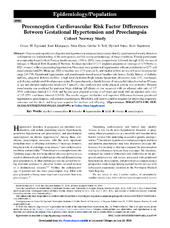| dc.contributor.author | Egeland, Grace M. | en_US |
| dc.contributor.author | Klungsøyr, Kari | en_US |
| dc.contributor.author | Øyen, Nina | en_US |
| dc.contributor.author | Tell, Grethe Seppola | en_US |
| dc.contributor.author | Næss, Øyvind | en_US |
| dc.contributor.author | Skjaerven, Rolv | en_US |
| dc.date.accessioned | 2016-09-07T08:48:39Z | |
| dc.date.available | 2016-09-07T08:48:39Z | |
| dc.date.issued | 2016 | |
| dc.Published | Hypertension 2016, 67(6):1173-1180 | eng |
| dc.identifier.issn | 1524-4563 | |
| dc.identifier.uri | https://hdl.handle.net/1956/12739 | |
| dc.description.abstract | Preconception predictors of gestational hypertension and preeclampsia may identify opportunities for early detection and improve our understanding of the pathogenesis and life course epidemiology of these conditions. Female participants in community-based Cohort Norway health surveys, 1994 to 2003, were prospectively followed through 2012 via record linkages to Medical Birth Registry of Norway. Analyses included 13 217 singleton pregnancies (average of 1.59 births to 8321 women) without preexisting hypertension. Outcomes were gestational hypertension without proteinuria (n=237) and preeclampsia (n=429). Mean age (SD) at baseline was 27.9 years (4.5), and median follow-up was 4.8 years (interquartile range 2.6–7.8). Gestational hypertension and preeclampsia shared several baseline risk factors: family history of diabetes mellitus, pregravid diabetes mellitus, a high total cholesterol/high-density lipoprotein cholesterol ratio (>5), overweight and obesity, and elevated blood pressure status. For preeclampsia, a family history of myocardial infarction before 60 years of age and elevated triglyceride levels (≥1.7 mmol/L) also predicted risk while physical activity was protective. Preterm preeclampsia was predicted by past-year binge drinking (≥5 drinks on one occasion) with an adjusted odds ratio of 3.7 (95% confidence interval 1.3–10.8) and by past-year physical activity of ≥3 hours per week with an adjusted odds ratio of 0.5 (95% confidence interval 0.3–0.8). The results suggest similarities and important differences between gestational hypertension, preeclampsia, and preterm preeclampsia. Modifiable risk factors could be targeted for improving pregnancy outcomes and the short- and long-term sequelae for mothers and offspring. | en_US |
| dc.language.iso | eng | eng |
| dc.publisher | Wolters Kluwer | eng |
| dc.rights | Attribution CC BY-NC-ND | eng |
| dc.rights.uri | https://creativecommons.org/licenses/by-nc-nd/4.0/ | eng |
| dc.subject | alcohol consumption | eng |
| dc.subject | behavior | eng |
| dc.subject | Hypertension | eng |
| dc.subject | lipids | eng |
| dc.subject | Obesity | eng |
| dc.subject | preeclampsia | eng |
| dc.title | Preconception cardiovascular risk factor differences between gestational hypertension and preeclampsia: Cohort Norway study | en_US |
| dc.type | Peer reviewed | |
| dc.type | Journal article | |
| dc.date.updated | 2016-06-23T09:16:18Z | |
| dc.description.version | publishedVersion | en_US |
| dc.rights.holder | Copyright 2016 The Authors | |
| dc.identifier.doi | https://doi.org/10.1161/hypertensionaha.116.07099 | |
| dc.identifier.cristin | 1363499 | |

